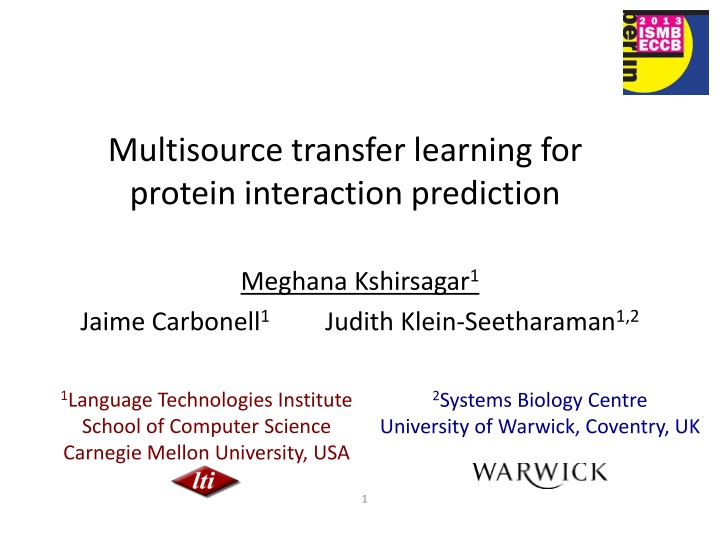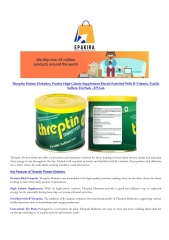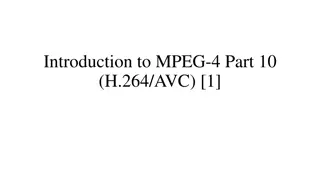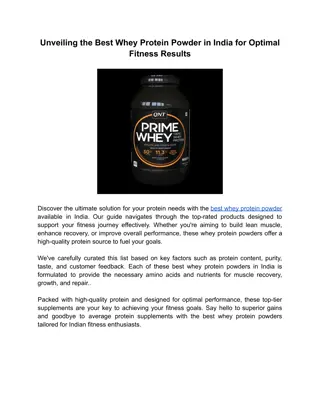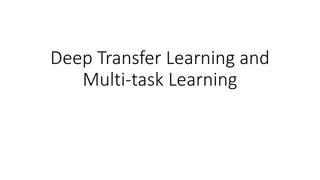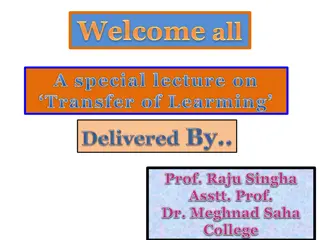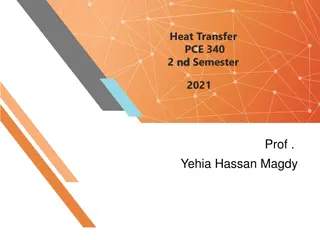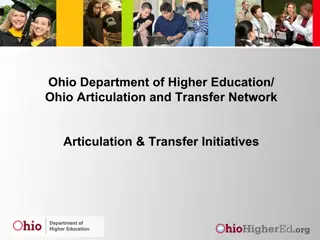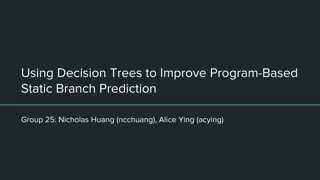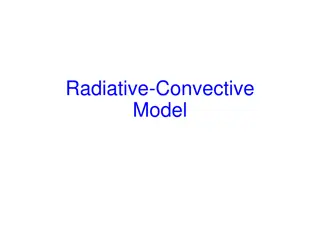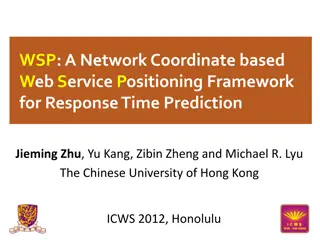Multisource transfer learning for protein interaction prediction
This study explores the efficacy of multisource transfer learning in predicting protein interactions. The research, conducted by Meghana Kshirsagar, Jaime Carbonell, and Judith Klein-Seetharaman, demonstrates the application of this approach in the context of protein interaction prediction. The experimental results, drawn from Language Technologies Institute at Carnegie Mellon University and Systems Biology Centre at the University of Warwick, highlight the potential of leveraging multiple data sources for accurate prediction models.
Download Presentation

Please find below an Image/Link to download the presentation.
The content on the website is provided AS IS for your information and personal use only. It may not be sold, licensed, or shared on other websites without obtaining consent from the author.If you encounter any issues during the download, it is possible that the publisher has removed the file from their server.
You are allowed to download the files provided on this website for personal or commercial use, subject to the condition that they are used lawfully. All files are the property of their respective owners.
The content on the website is provided AS IS for your information and personal use only. It may not be sold, licensed, or shared on other websites without obtaining consent from the author.
E N D
Presentation Transcript
Multisource transfer learning for protein interaction prediction Meghana Kshirsagar1 Jaime Carbonell1 Judith Klein-Seetharaman1,2 1Language Technologies Institute School of Computer Science Carnegie Mellon University, USA 2Systems Biology Centre University of Warwick, Coventry, UK 1
Infectious diseases: Host pathogen interactions Y. pestis B. anthracis S. typhi Electron micrograph showing Salmonella typhimurium invading human cells (source: NIH) Protein protein interactions between host and pathogen are important to understand diseases! 2
Outline 1. Introduction to protein interaction prediction 2. Multi-source learning using a Kernel-mean matching based approach 3. Results 3
1. Protein-interaction prediction: Background 4
Discovery of host-pathogen protein interactions : Challenges Bio-chemical methods (co-IP, NMR, Y2H assay) Cross-species interaction studies are hard Expensive and time-consuming Prohibitively large set of possible interactions Example: human-B. anthracis protein pairs 2321 proteins in B. anthracis, 25000 human proteins 2321 x 25000 60 x 106 protein pairs to test! Computational methods (statistical, algorithmic) Rely on availability of known, high-confidence interactions Often, very few or no interactions may exist for the organism of interest 5
Predicting host pathogen protein interactions Known interactions curated by several databases such as: PHI-BASE, PHISTO, HPIDB, VirusMint etc. Predicting unknown interactions: Use known interactions as training data for a classifier Obtain features (using protein sequence, protein domains etc.) 6
Machine Learning approaches host pathogen Two classes (i.e label Y): 1 - interacting 0 - non-interacting Known interactions (training data) X Training Build classifier model Prediction For new protein pairs, generate features and apply model Feature Generation [f1, f2 . . . . fN] f2 f2 Gene Ontology (GO) Gene Expression (GEO) Uniprot (sequence) x model f1 f1 + : interacting pairs : non-interacting pairs We use random protein pairs 7
Transfer Learning setting Target Task (T) Source Tasks (S) Task-3 Task-1 Task-2 (x1 , ?) (x2 , ?) (xn3 , ?) (x1 , y1) (x2 , y2) (xn1, yn1) (x1 , y1) (x2 , y2) (xn2, yn2) No If all tasks identical, P (S) = P (T) Train on S, test on T labeled data
Reweighting the source Target Task (T) Source Tasks (S) Task-3 Task-1 Task-2 (x1 , ?) (x2 , ?) (xn3 , ?) (x1 , y1) (x2 , y2) (xn1, yn1) (x1 , y1) (x2 , y2) (x3 , y3) (xn2, yn2) How to find the most relevant source examples?
Kernel Mean Matching Huang, Smola et al. NIPS 2007 KMM allows us to select examples soft selection using the features xi from all tasks Reweighs source examples to make them look similar to target examples -- MMD 11
Spectrum RBF kernel Protein sequence based RBF (Radial Basis Function) kernel over sequence features Sequence features: incorporate physiochemical properties of amino acids compute k-mers for k=2, 3, 4, 5 frequency of these k-mers 12
Step 1 : Instance reweighting Source Tasks (S) Task-1 Task-2 Source instances with weight (x1 , y1) i> 0 (x2 , y2) (x3 , y3) (xn1, yn1) Train models 1 2 K number of hyperparameters
Step 2 : Model selection 1 2 K * Two techniques: 1. Class-skew based selection 2. Reweighted cross-validation 14
3. Results 15
Models compared 1. Inductive Kernel-SVM assumes P(S) = P(T) 2. Transductive SVM treat target task as test data 3. KMM + Kernel-SVM with two model selection strategies: Class-skew based (skew) Reweighted cross-validation (rwcv) 16
Datasets Human F. tularensis Human - E. coli Human - Salmonella Plant Salmonella No. of known interactions 1380 32 62 0 Cannot evaluate on Plant Salmonella Use other tasks for quantitative evaluation 17
10-fold cross-validation: Average F1 Train 8 folds 1 fold 1 fold Held-out Test 18
Plant Salmonella interactome Preliminary analysis of predictions shows enrichment of interesting plant processes Expanded model with additional tasks: A. thaliana Agrobact. tumefaciens A. thaliana E. coli A. thaliana - Pseudomonas syringae A. thaliana Synechocystis Predictions currently under validation 20
Conclusion Presented a technique to predict PPI in tasks with no supervised data Advantages: Simple and intuitive method Can use different feature spaces for each task Disadvantages: Kernel-SVM model is slow Model selection is challenging 21
References J. Huang, A. Smola, A. Gretton, K.M. Borgwardt, and B. Scholkopf. Correcting sample selection bias by unlabeled data. NIPS, 2007. Schleker, S., Sun, J., Raghavan, B., et al. (2012). The current salmonella-host interactome. Proteomics Clin Appl. 22
Questions ? 23
PHISTO1Pathogens and their interactions data 1000 1 10 100 (logscale) 0 2 3 4 M.arthriti M. anthritidis C. sordelli C.sordelli C. difficile C.difficil C. botulinum C.botulinu S. dysgalactiae S.dysgalac S. pyrogenes S.pyogenes L. monocytogenes B. anthracis L.monocyto B.anthraci S. aureus S.aureus C.trachoma C. trachomatis N.meningit N. meningitidis Number of host-pathogen interactions in the database V.cholerae V. cholerae E.coliO157 E. coli-O15 E. coli-K12 E.coliK12 S.enterica S. enterica Y.pseudotu Y. pseudotubercu. Y. pestis Phylogenetic tree of the pathogen species Y.pestis Y.enteroco Y. enterocolitica S.flexneri S. flexneri L.pneumoph L. pneumophila M. catarrhalis M.catarrha P. aeruginosa P.aerugino F. tularensis F.tularens H. pylori-J9 H.pyloriJ9 C. jejuni C.jejuni 24
Infectious diseases : manifestation statistics Illnesses Hospitalization Deaths Bacterial Parasitic 5,204,934 2,541,316 45,826 12,010 1,468 827 Viral 30,833,391 123,341 433 Total 38,629,641 181,177 2,718 Source: CDC (Center for Disease Control), US 2011 25
